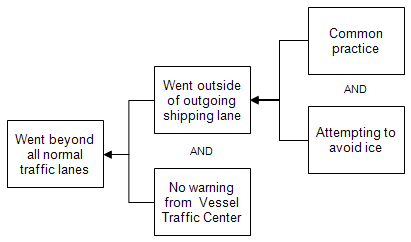Step 2: Identify the Causes (Analysis)
The analysis step is where the incident is broken down into causes which are captured on the Cause Map. A thorough root cause analysis built as a Cause Map captures all of the causes in a simple, intuitive format. The Cause Map starts by writing down the goals that were affected as defined in problem outline. For the VALDEZ oil spill, the
 environmental goal was impacted because of the oil released into the environment and the cleanup required. The material goals were impacted by the lost product and the repair required to the vessel. The community goal was impacted by the punitive damages and settlements. These are the first cause-and-effect relationships in the analysis
environmental goal was impacted because of the oil released into the environment and the cleanup required. The material goals were impacted by the lost product and the repair required to the vessel. The community goal was impacted by the punitive damages and settlements. These are the first cause-and-effect relationships in the analysis
 The analysis can continue by asking Why questions and moving to the right of either of the cause-and-effect relationships above. In this example we’ll start with the cleanup costs, the punitive damages/settlement, and the lost product, which were caused by 10.8 million gallons of oil being released into the environment.
The analysis can continue by asking Why questions and moving to the right of either of the cause-and-effect relationships above. In this example we’ll start with the cleanup costs, the punitive damages/settlement, and the lost product, which were caused by 10.8 million gallons of oil being released into the environment.
 The 10.8 million gallons of oil being released into the environment were also an impact to the environmental goals. The oil was released because eight oil cargo tanks ruptured, which caused the need for the repairs to the vessel, which was also an impact to the goals.
The 10.8 million gallons of oil being released into the environment were also an impact to the environmental goals. The oil was released because eight oil cargo tanks ruptured, which caused the need for the repairs to the vessel, which was also an impact to the goals.
 The cargo tanks were ruptured because of inadequate hull strength, due to a single-hulled vessel design, and the vessel’s significant impact with Bligh Reef.
The cargo tanks were ruptured because of inadequate hull strength, due to a single-hulled vessel design, and the vessel’s significant impact with Bligh Reef.
 The vessel’s significant impact with the reef was due to the ship turning too slowly when the turn was ordered, because the vessel had unknowingly been left on auto-pilot. Additional factors (which we will discuss in more detail below) that caused the vessel’s impact with the reef are: 1) the vessel went beyond all normal traffic lanes, 2) the speed of the vessel, and 3) the crew didn’t realize the vessel was too close to the reef.
The vessel’s significant impact with the reef was due to the ship turning too slowly when the turn was ordered, because the vessel had unknowingly been left on auto-pilot. Additional factors (which we will discuss in more detail below) that caused the vessel’s impact with the reef are: 1) the vessel went beyond all normal traffic lanes, 2) the speed of the vessel, and 3) the crew didn’t realize the vessel was too close to the reef.
 The vessel went beyond all normal traffic lanes because it went outside the outgoing shipping lane, which was common practice and required to avoid the ice which completely covered the outgoing shipping lane. Additionally, the vessel received no warning from the Vessel Traffic Center when it went out of bounds.
The vessel went beyond all normal traffic lanes because it went outside the outgoing shipping lane, which was common practice and required to avoid the ice which completely covered the outgoing shipping lane. Additionally, the vessel received no warning from the Vessel Traffic Center when it went out of bounds.
 The Vessel Traffic Center (VTC) did not provide a warning to VALDEZ when she went out of bounds because the VTC was unaware of the vessel’s position, because the VTC did not plot vessel positions and had lost radar contact due to inadequate radar coverage. Additionally, procedures for departure from traffic lanes were not followed, according to testimony. (Gathering testimony is an important part of the root cause analysis process. Testimony is used to help create the Cause Map.)
The Vessel Traffic Center (VTC) did not provide a warning to VALDEZ when she went out of bounds because the VTC was unaware of the vessel’s position, because the VTC did not plot vessel positions and had lost radar contact due to inadequate radar coverage. Additionally, procedures for departure from traffic lanes were not followed, according to testimony. (Gathering testimony is an important part of the root cause analysis process. Testimony is used to help create the Cause Map.)
 The vessel was traveling at nearly all ahead full, despite the Master reporting that he would be reducing the vessel’s speed. For an unknown reason, he did not.
The vessel was traveling at nearly all ahead full, despite the Master reporting that he would be reducing the vessel’s speed. For an unknown reason, he did not.

Go to:
Step 2. Identify the Causes (The Analysis) – Page 1 – Page 2
Step 3. Select the Best Solutions (Reduce the Risk)
Download the one-page PDF summary of the EXXON Oil Spill Root Cause Analysis.
This example was made using our root cause analysis template.